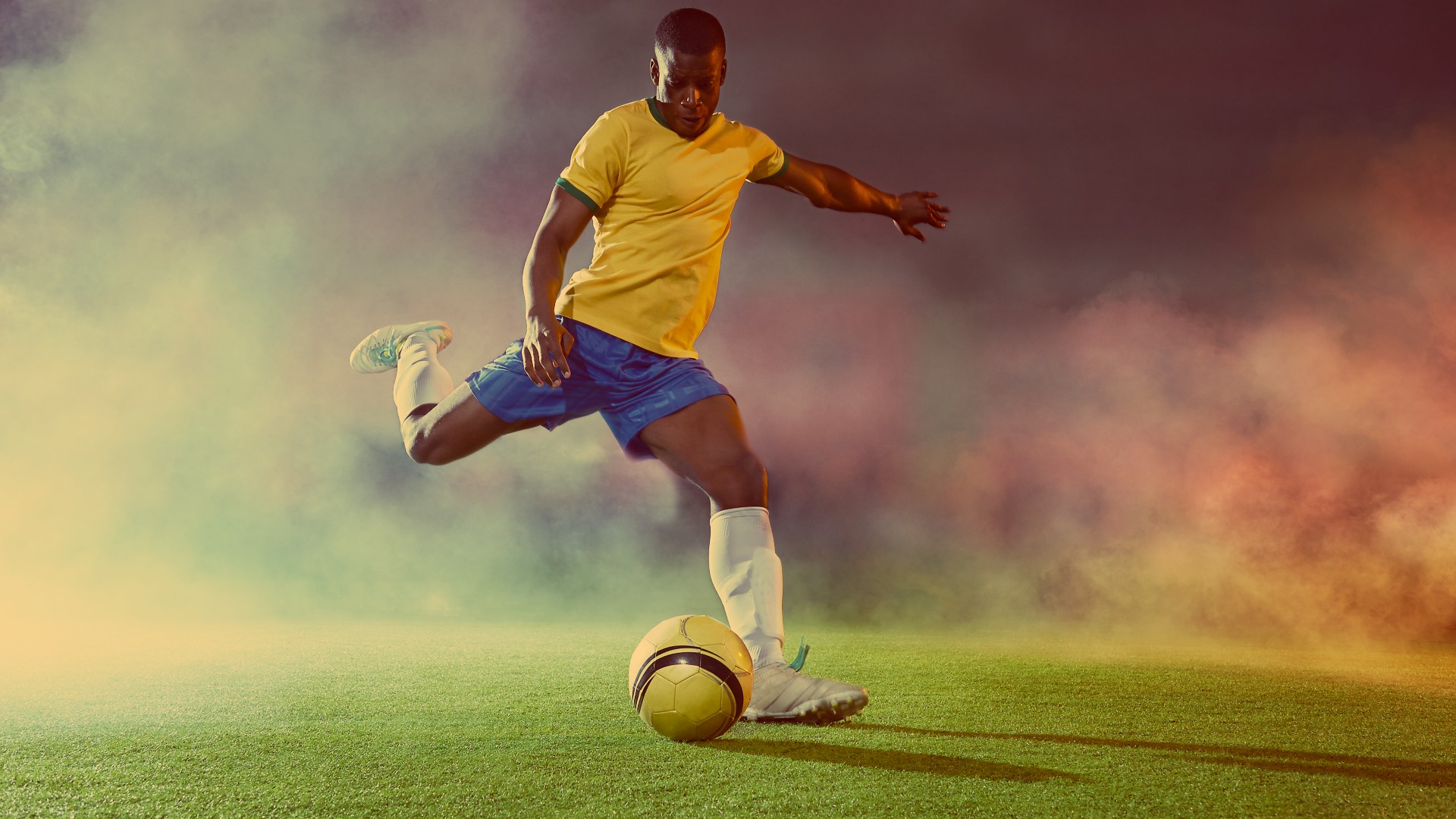
With the World Cup final fast approaching, have you wondered what football workouts or exercises elite players do? We know they’re some of the fittest athletes in the world, with seriously grueling training undertaken by these sinewed powerhouse players. But it’s hard to piece together what training looks like unless you’ve stalked your favorite players on social media (guilty).
The personal trainers at Fitness Superstore have been deliberating over what it takes to work out like pro players, so now you can get match fit too. It’s not impossible to find inspiration — GOAT Ronaldo (let’s not get caught up in that debate right now) has shared his CR7 workouts widely online, and PSG has posted a sneak peek of a training day with Mbappé — but it’s hard to nail down specifics.
Keoghan Bellew, one of the creators of the workout, said, “professional players undergo rigorous daily training to prepare for major events like the World Cup. While you may not be able to emulate their exact regime, you can certainly let it inspire your workouts — whether you play or not.”
So, if you want to belt in balls like Mbappé or train like Harry Kane, read on for this World Cup inspired football workout.
What is the World Cup workout?
To make it to an elite level, players must be physically and mentally fit across several scores of fitness like strength, cardio, endurance, agility, coordination, and balance.
The team at FS has developed a workout that encompasses these components to help you train more like the pros. Bellew adds, “with plenty of cardio balanced by strength and conditioning workouts, soccer-style training is a great way to build up stamina, agility, and full-body fitness. Remember, while cardio fitness is the main focus of a player's regime, weight training, and proper recovery are vital for building strength, preventing injury, and improving performance.”
One of the best treadmills or best exercise bikes are advised but not compulsory, and adding conditioning equipment like adjustable dumbbells, kettlebells, resistance bands, and ab wheels will elevate your home workouts. If you’re done piecing together a training plan from social media platforms, here’s a workout plan to put you through the wringer.
Get instant access to breaking news, the hottest reviews, great deals and helpful tips.
1. Start with cardio
If you’ve wondered how the England players make 90 minutes in the Qatar heat look like a holiday, it’s serious cardio fitness.
According to SQAF, professional footballers cover around 6.2 miles or 10km per game. The distance covered per match varies depending on your position. Full-backs and central defenders can expect to clock up 6.8 miles/11km per 90 minutes, while it’s no surprise goalkeepers cover less ground (around 2.5 miles/4km). After all, according to That Peter Crouch Podcast — goalkeepers are a “different breed.”
Stamina and endurance are key, but how do you train for them? Alongside the hours spent on the pitch, professional players supplement their training with cardio, like running, cycling, and interval training. Regardless of the method, try to add some endurance sessions on non-strength days or as a warm-up.
2. Add treadmill intervals
Strikers need power to generate bursts of speed at a moment’s notice, so HIIT is an effective way to improve stamina and agility. As well as incorporating longer runs outside or on the treadmill, you can improve your overall speed and endurance using interval workouts.
Try this simple interval workout:
- Set your machine to a 1% incline
- Jog at a medium pace for ten minutes to warm up
- Ramp up the speed to reach maximum effort and sprint for 30 seconds
- Return to your average jogging pace for 3 minutes
Repeat at least five times to guarantee a solid interval session that will do wonders for your cardio fitness. Retired Chelsea legend John Terry (while not a striker) regularly posts savage HIIT treadmill workouts to his Instagram if you need more inspiration.
A post shared by John Terry (@johnterry.26)
A photo posted by on
3. Spinning on a stationary bike
Running doesn’t have to be your only source of cardio. A stationary exercise bike is a low-impact way to maintain stamina at home and packs similar benefits to running.
Cycling is excellent for building overall leg strength and works your core muscles to keep you upright, which is also a brilliant supplement to football exercises. The best home gym equipment can help you work out like the pros by simply hopping on a bike for 30 minutes before or after work or as a warm-up or cool-down.
Here are the best Peloton classes to try for more inspiration.
4. Incorporate strength training and conditioning
Cardio paired with strength training will build strength in relevant muscle groups. Strengthening the glutes and calves can help players improve speed and become more explosive when sprinting. Building strength in the key muscles used during football also protects players’ joints and prevents injury or overuse.
Athletes must maintain a good level of strength and fitness across the whole body, but some of the major muscles used in football include the quads, calves, hip flexors, groin, hamstrings, and Achilles tendons. Below are some targeted strength exercises to try, and you can also access Euro star Chloe Kelly’s leg workout here.
Dumbbell bench step-ups
Recommended by Tony Strudwick, ex-Head of Performance at Manchester United, this exercise — posted on FourFourTwo — helps players develop power and transition from a sprint to a jump to reach those all-important headers. The move works on single-leg stability, which improves muscle imbalances and coordination when changing direction quickly during a game.
How: Hold a medium-weight dumbbell in each hand and stand next to a bench. Place your closest foot onto the bench and push yourself up to stand, powering through your glutes and calves. Repeat for 3-4 sets and 8-15 reps per side added to lower body workouts.
Medicine ball push-ups
Although your legs are focal in football training, it’s ideal to work on your core and upper body strength too. Doing push-ups off a medicine ball provides an unstable environment that challenges core strength and stability and improves your balance. Just be sure to distribute your weight as evenly as possible through both hands so the ball doesn’t roll away. Try 3-4 sets and 8-15 reps added to upper body workouts., like this 20-minute kettlebell workout.
5. Stretching and mobility
Aim for at least ten minutes of proper stretching after each workout, including foam rolling in your cool-down routine; this can help prevent the dreaded DOMS (delayed onset muscle soreness) after a tough session and tease out muscular tension. Find out five stretching mistakes you’re probably making beforehand, and check out our best foam rollers guide for more info. Alongside stretching, let your body recover with plenty of healthy food, water, and sleep to provide enough energy to train like the pros.
Are you tuning in for the World Cup final? Find the best soccer streams for free.
Next up: I tried 8 cable pull throughs every day for a week here’s what happened, and this 7-move kettlebell leg workout builds bigger legs.

Sam Hopes is a level 3 qualified trainer, a level 2 Reiki practitioner and fitness editor at Tom's Guide. She is also currently undertaking her Yoga For Athletes training course.
Sam has written for various fitness brands and websites over the years and has experience across brands at Future, such as Live Science, Fit&Well, Coach, and T3.
Having coached at fitness studios like F45 and Virgin Active and personal trained, Sam now primarily teaches outdoor bootcamps, bodyweight, calisthenics and kettlebells.
She also coaches mobility and flexibility classes several times a week and believes that true strength comes from a holistic approach to training your body.
Sam has completed two mixed doubles Hyrox competitions in London and the Netherlands and finished her first doubles attempt in 1:11.
